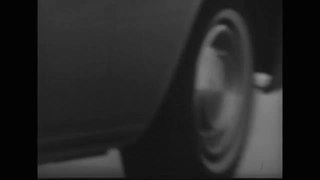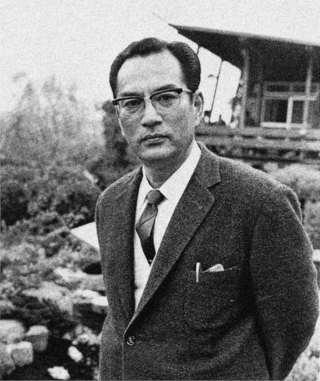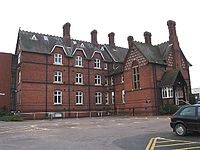A white cane is a device used by many people who are blind or visually impaired. A white cane primarily allows its user to scan their surroundings for obstacles or orientation marks, but is also helpful for onlookers in identifying the user as blind or visually impaired and taking appropriate care. The latter is the reason for the cane's white colour, which in many jurisdictions is mandatory.
Blindsight is the ability of people who are cortically blind to respond to visual stimuli that they do not consciously see due to lesions in the primary visual cortex, also known as the striate cortex or Brodmann Area 17. The term was coined by Lawrence Weiskrantz and his colleagues in a paper published in a 1974 issue of Brain. A previous paper studying the discriminatory capacity of a cortically blind patient was published in Nature in 1973. The assumed existence of blindsight is controversial, with some arguing that it is merely degraded conscious vision.
Human echolocation is the ability of humans to detect objects in their environment by sensing echoes from those objects, by actively creating sounds: for example, by tapping their canes, lightly stomping their foot, snapping their fingers, or making clicking noises with their mouths. People trained to orient by echolocation can interpret the sound waves reflected by nearby objects, accurately identifying their location and size.

The subject of blindness and education has included evolving approaches and public perceptions of how best to address the special needs of blind students. The practice of institutionalizing the blind in asylums has a history extending back over a thousand years, but it was not until the 18th century that authorities created schools for them where blind children, particularly those more privileged, were usually educated in such specialized settings. These institutions provided simple vocational and adaptive training, as well as grounding in academic subjects offered through alternative formats. Literature, for example, was being made available to blind students by way of embossed Roman letters.

An assistive cane is a walking stick used as a crutch or mobility aid. A cane can help redistribute weight from a lower leg that is weak or painful, improve stability by increasing the base of support, and provide tactile information about the ground to improve balance. In the US, ten percent of adults older than 65 years use a cane, and 4.6 percent use walkers.

Visual or vision impairment is the partial or total inability of visual perception. In the absence of treatment such as corrective eyewear, assistive devices, and medical treatment, visual impairment may cause the individual difficulties with normal daily tasks, including reading and walking. The terms low vision and blindness are often used for levels of impairment which are difficult or impossible to correct and significantly impact daily life. In addition to the various permanent conditions, fleeting temporary vision impairment, amaurosis fugax, may occur, and may indicate serious medical problems.

The Royal National College for the Blind (RNC) is a co-educational specialist residential college of further education based in the English city of Hereford. Students who attend the college are aged 16 to 25 and blind or partially sighted. They can study a wide range of qualifications at RNC, from academic subjects such as English and Mathematics to more vocational topics such as Massage and Complementary Therapies. Alongside regular further education subjects and vocational training, the college offers training in mobility, assistive technology, Braille, independent living skills and personal development.

Tactile paving is a system of textured ground surface indicators found at roadsides, by and on stairs, and on railway station platforms, to assist pedestrians who are vision impaired.

Queen Alexandra College (QAC) is an independent specialist college of further education based in Harborne, Birmingham for students above the age of sixteen with visual impairment, autism and other disabilities. Students can develop their academic, social, employment and independent skills through individualised programmes. QAC also offers many leisure activities. Its registered charity number 1065794.
Cortical visual impairment (CVI) is a form of visual impairment that is caused by a brain problem rather than an eye problem. Some people have both CVI and a form of ocular visual impairment.

A mobility aid is a device that helps individuals with mobility impairments to walk or improve their overall mobility.

Orientation and Mobility, or O&M, is a profession which focuses on instructing individuals who are blind or visually impaired with safe and effective travel through their environment. Individual O&M specialists can work for schools, government agencies or work as private contractors. The Academy for Certification of Vision Rehabilitation and Education Professionals (ACVREP) offers certification for vision rehabilitation professionals in the United States.
The Birmingham Royal Institution for the Blind (BRIB) is a registered charity in the United Kingdom which has provided education, technology, guidance and support for Birmingham's visually impaired community for over 150 years.
A sighted guide is a person who guides a person with blindness or vision impairment.

Linden Lodge School for the Blind is a specialist sensory and physical college located in Wimbledon, South London, England. It educates visually impaired children aged between two and nineteen, including those who are multi-disabled visually impaired.
Henshaws Society for Blind People is a specialist charity providing support, advice and training to anyone affected by sight loss and other disabilities.
Acoustic wayfinding is the practice of using the auditory system to orient oneself and navigate physical space. It is commonly used by the visually impaired, allowing them to retain their mobility without relying on visual cues from their environment.

B2 is a medical based Paralympic classification for blind sport. Competitors in this classification have vision that falls between the B1 and B3 classes. The International Blind Sports Federation (IBSA) defines this classification as "visual acuity ranging from LogMAR 1.50 to 2.60 (inclusive) and/or visual field constricted to a diameter of less than 10 degrees." It is used by a number of blind sports including para-alpine skiing, para-Nordic skiing, blind cricket, blind golf, five-a-side football, goalball and judo. Some sports, including adaptive rowing, athletics and swimming, have equivalents to this class.

Jyothirgamaya Foundation is a nonprofit organization, based in Thiruvananthapuram Kerala which is actively involved in the empowerment of persons with visual impairment founded in 2015 by Tiffany Brar. The project started as a mobile blind school in 2012. Tiffany Brar herself, traveled through rural areas in public transport in search of blind people of all ages in rural areas in India, with the aim of bringing out of the four walls of their house, to which they are confined, and brings a new light to their eyes, which has nothing to do with their eyesight. Jyothirgamaya Foundation holds Special consultative status with United Nations.

Seiichi Miyake was a Japanese engineer and inventor best known for his work on tactile paving to aid the visually impaired at traffic crossings. Miyake's system of tactile paving was first introduced at a school for the blind in Okayama City in March 1967, and has since been adopted around the world.












